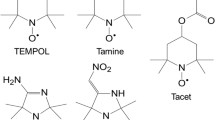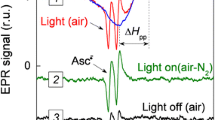Abstract
In a previous paper it was shown that photoinhibition of reaction centre II of spinach thylakoids was predominantly caused by the degradation of D1-protein. An initial inactivation step at the QB-site was distinguished from its breakdown. The present paper deals with the question as to whether this loss of QB-function is caused by oxygen radical attack. For this purpose the photoinhibition of thylakoids was induced at 20°C in the presence of either superoxide dismutase and catalase or the antioxidants glutathione and ascorbic acid. This resulted in comparable though not total protection of D1-protein, photochemistry and fluorescence from photoinhibition. The combined action of both the enzymatic and the non-enzymatic radical scavenging systems brought about an even more pronounced protective effect against photoinhibition than did either of the two systems singularly at saturating concentrations. The results signify a major contribution of activated oxygen species to the degradation process of D1-protein and the related phenomena of photoinhibition. Thylakoids treated with hydroxyl radicals generated through a Fenton reaction showed a loss of atrazine binding sites, electron transport capacity and variable fluorescence in a similar manner, though not to the same extent, as usually observed following photoinhibitory treatment.
Similar content being viewed by others
Abbreviations
- Asc:
-
ascorbate
- Fecy:
-
ferricyanide
- GSH:
-
reduced glutathione
- PQ:
-
plastoquinone
- QA :
-
primary quinone acceptor of PS II
- QB :
-
secondary quinone acceptor of PS II
- SOD:
-
superoxide dismutase
References
Arntz B and Trebst A (1986) On the role of the QB protein of PS II in photoinhibition. FEBS Lett 194: 43–49
Asada K and Takahashi M (1987) Production and scavenging of active oxygen in photosynthesis. In: Kyle DJ, Osmond CB and Arntzen CJ (eds) Topics in Photosynthesis, Photoinhibition, Vol 9, pp 227–288. Amsterdam: Elsevier
Barényi B and Krause G (1985) Inhibition of photosynthetic reactions by light. A study with isolated spinach chloroplasts. Planta 163: 218–226
Björkman O (1987) High irradiance stress in higher plants and interaction with other stress factors. In: Biggins J (ed) Progress in Photosynthesis Research, Vol 4, pp 11–18. Dordrecht: Martinus Nijhoff Publishers
Dean R and Pollak J (1985) Endogenous free radical generation may influence proteolysis in mitochondria. Biochem Biophys Res Commun 126: 1082–1089
Foyer C and Halliwell B (1976) The presence of glutathione and glutathione reductase in chloroplasts: A proposed role in ascorbic acid metabolism. Planta 133: 21–25
Halliwell B (1984) Toxic effects of oxygen on plant tissues. In: Chloroplast Metabolism. The Structure and Function of Chloroplasts in Green Leaf Cells, pp 180–206. Oxford: Clarendon Press
Halliwell B and Ahluwalia S (1976) Hydroxylation of p-coumaric acid by horseradish peroxidase. The role of superoxide and hydroxyl radicals. Biochem J 153: 513–518
Heber U and Krause G (1980) What is the physiological role of photorespiration? TIBS 5: 32–34
Hoey B and Butler J (1984) The repair of oxidized amino acids by antioxidants. Biochim Biophys Acta 791: 212–218
Knox J and Dodge A (1985) The photodynamic action of eosin, a singlet oxygen generator. The inhibition of photosynthetic electron transport. Planta 164: 30–34
Krause G and Cornic G (1987) CO2 and O2 interactions in photoinhibition. In: Kyle DJ, Osmond CB and Arntzen CJ (eds) Topics in Photosynthesis, Photoinhibition, Vol. 9, pp 169–196. Amsterdam: Elsevier
Krause G, Kirk M, Heber U and Osmond C (1978) O2-dependent inhibition of photosynthetic capacity in intact isolated chloroplasts and isolated cells from spinach leaves illuminated in the absence of CO2. Planta 142: 229–233
Krause GH, Köster S and Wong SC (1985) Photoinhibition of photosynthesis under anaerobic conditions studied with leaves and chloroplasts of Spinacia oleracea L. Planta 165: 430–438
Krause G and Laasch H (1987) Photoinhibition of photosynthesis. Studies on the mechanism of damage and protection in chloroplasts. In: Biggins J (ed) Progress in Photosynthesis Research, Vol 4, pp 19–26. Dordrecht: Martinus Nijhoff Publishers
Larson R (1988) The antioxidants of higher plants. Phytochemistry 27: 969–978
Levine R (1983) Oxidative modification of glutamine synthetase I. Inactivation is due to loss of one histidine residue. J Biol Chem 258: 11823–11827
Mehler A (1951) Studies on reactions of illuminated chloroplasts. I. Mechanism of the reduction of oxygen and other hill reagents. Arch Biochem Biophys 33: 65–77
Nair P and Vaidyanathan C (1964) A colorimetric method for determination of pyrocatechol and related substances. Anal Biochem 7: 315–321
Packer J, Slater T and Willson R (1979) Direct observation of a free radical interaction between vitamin E and vitamin C. Nature 278: 737–738
Powles S, Osmond C and Thorne S (1979) Photoinhibition of intact attached leaves of C3 plants illuminated in the absence of both carbon dioxide and of photorespiration. Plant Physiol 64: 982–988
Richter M, Rühle W and Wild A (1990) Studies on the mechanism of photosystem II Photoinhibition. I. A two step degradation of D1-protein. Photosynth Res 24: 229–235
Scarpa M, Rigo A, Maiorino M, Ursini F and Gregolin C (1984) Formation of α-tocopherol radical and recycling of α-tocopherol by ascorbate during peroxidation of phosphatidylcholine liposomes. Biochim Biophys Acta 801: 215–219
Takahama U and Nishimura M (1975) Formation of singlet molecular oxygen in illuminated chloroplasts. Effects on photoinactivation and lipid peroxidation. Plant Cell Physiol 16: 737–748
Wolff S and Dean R (1986) Fragmentation of proteins by free radicals and its effect on their susceptibility to enzymic hydrolysis. Biochem J 234: 399–403
Wolff S, Garner A and Dean R (1986) Free radicals, lipids and protein degradation. TIBS 11: 27–31
Author information
Authors and Affiliations
Rights and permissions
About this article
Cite this article
Richter, M., Rühle, W. & Wild, A. Studies on the mechanism of photosystem II photoinhibition II. The involvement of toxic oxygen species. Photosynth Res 24, 237–243 (1990). https://doi.org/10.1007/BF00032311
Accepted:
Issue Date:
DOI: https://doi.org/10.1007/BF00032311




